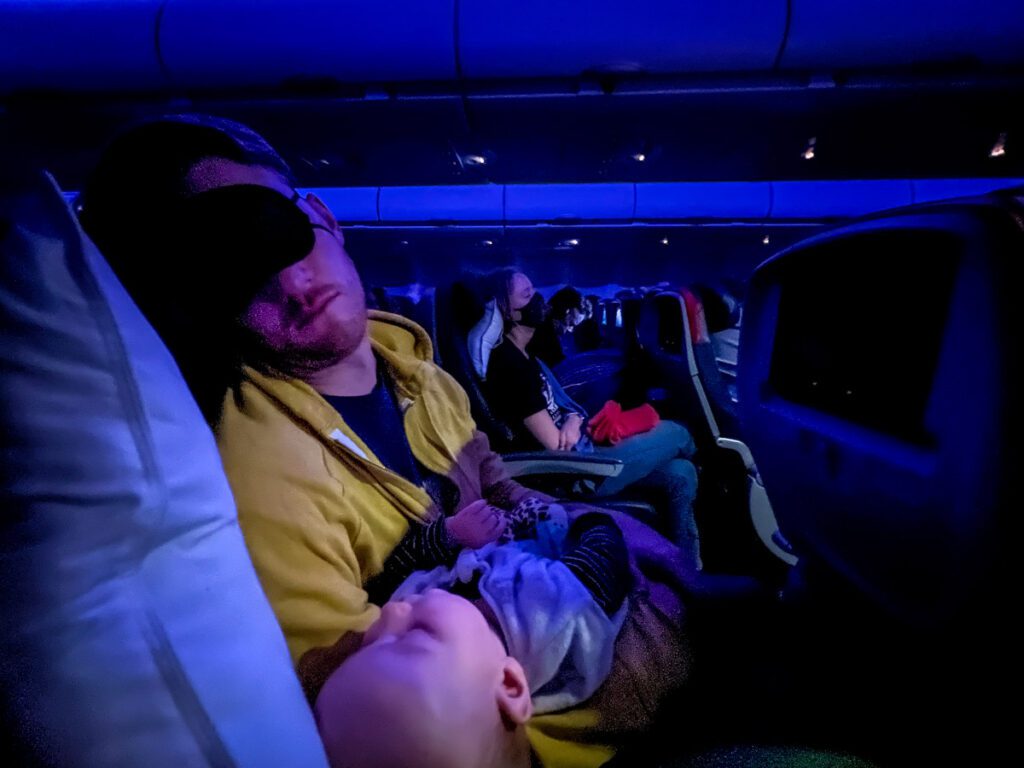If you’re planning some long distance travel, these expert jet lag tips will help you adjust to a new time zone faster, so you can feel refreshed and make the most of your trip. From in-flight hacks to post-arrival strategies, these are the methods that have personally worked for us!

Jet lag—every traveler’s worst enemy. You finally arrive at your dream destination, but instead of hitting the ground running, you’re wide awake at 3 a.m. and crashing by mid-afternoon.
Sound familiar?
Whether you’re hopping across a few time zones or traveling halfway around the world, jet lag can throw off your sleep schedule, zap your energy, and make those first few days of your trip a struggle.
But don’t worry! With a few smart strategies, you can minimize the effects of jet lag and adjust to a new time zone faster.
This article is based on our experience and is full of tips that have worked for us, personally. We enlisted the help of our team member Amanda, who’s also become a bit of a pro at fighting off jet lag, to give us some of her best tips as well.
Pick and choose which ones speak to you and hopefully you’ll find some strategies that work for you too!
Our experience with jet lag

When we started this blog all the way back in 2014 (how has it already been that long?! 🤯), we lived out of our suitcases for nearly 6 years. Even now that we have a homebase, we continue to travel across continents regularly, including with our first born and new baby, and we’ve been combating jet lag every step of the way.
Suffice to say, we’ve been through a lot of time zone changes.
We’ve made plenty of mistakes along the way and paid the price with jet lag. However, over the past few years (especially since our daughter was born) we’ve really honed our jetlag fighting skills and have a routine down solid.
We no longer suffer from midnight wake ups and midday crashes when flying from continent to continent.
In this article we’re going to share all of our jet lag tips with you so you too can combat jet lag like a pro and stay energized from the start for your next vacation, trip or adventure!
Amanda’s experience with jet lag

As a full time nomad, I’ve been living out of a suitcase since 2018, traveling the globe and combating jet lag every step of the way.
Over the past 7 years I’ve taken an average of 5 long haul flights per year (meaning 7+ hours in the air), typically moving between continents each time. And as of writing this, I’ve been in North America, Europe, back to North America, back to Europe and down to Africa in just the past month. (Whew! Even writing this makes my head spin!)
Needless to say, I’ve picked up some great jet lag tips along the way!
1. Try to adjust your sleep schedule on the flight

In our experience flying from the US to Europe or Asia, those long haul flights are often redeyes – or at least fly partially at night.
Instead of jumping right into movie mode, and staying awake to have an unnecessary meal (if your flight is after 8 p.m.), our best advice is to try to fall asleep as soon as possible.
Start adjusting your own sleep schedule the moment you take your seat on the plane. Meaning, if your flight is at 6 p.m., but it’s already midnight in your destination, you should do your best to get to sleep on the plane as soon as you can. And try to sleep as much as you are able until you land.
The nice thing is, airlines usually dim the cabin lights according to the time at the destination, and most people fall asleep. However, we like to bring ear plugs and a sleep mask on long haul flights to give us the best chance for an uninterrupted rest.
Amanda’s tip: I also find listening to my “sleep playlist”—a designated playlist with calming songs that I only use to fall asleep—helps trick my brain into sleep mode quickly on flights.
In the opposite case, if you are flying west from Europe or elsewhere, you will usually have an all day flight. Even if it’s 10 hours in the air, we do our best to stay awake the entire flight, or only allow for short 1 hour naps once or twice. That way we know we’ll be able to get to sleep at a normal hour after landing.
2. Stay awake until a reasonable bedtime when you reach your destination

How you handle the first day in a new destination will set the tone for the rest of your trip in combatting jet lag.
It doesn’t matter what time our flight lands in a new destination, we always recommend pushing yourself to stay awake until a reasonable hour for bedtime on that first day.
Now when we say reasonable, that might mean 8 p.m. for you. As long as you allow yourself 8-10 hours of sleep, sometimes a 6 a.m. wake up will actually work to your benefit. We love the experience of getting up bright and early before the crowds to explore a new destination.
For us, we usually aim to stay awake until 9 or 10 p.m. on that first day.
The only exception to this is if you land really early in the morning in your new destination (ex: a lot of overnight flights from the US land at early morning hours in Europe). Then we allow ourselves a strictly timed nap—but only on our first day…
3. No napping after the first day

If you land in a new destination before noon local time, it can be pretty challenging to stay awake for a complete 10-12 hours until my “reasonable bedtime.”
If—and only if—this is the case, you can allow yourself a strictly timed midday nap on your first day.
It is said that 15-20 minute power naps are the most effective. However, depending on how little sleep we got on the flight, we will sometimes give ourselves 1-2 hours to catch up on sleep midday.
It will be challenging to wake up after your nap and you will have to fight the urge to stay in bed all day, but I promise you if you force yourself awake, it will work to your benefit.
After day one, we have a no napping policy because we don’t want our bodies to get used to that cadence and midday naps aren’t usually part of our routine.
4. Take Melatonin – even if you are tired

One of the best jet lag tips we actually learned from Amanda is using Melatonin* to our advantage.
If you don’t already know, Melatonin is a hormone produced by the body when it’s getting ready to fall asleep. You can also get Melatonin as a supplement (typically over the counter – without a prescription) that comes in pill form. It’s used to mimic your body’s natural reaction to an approaching bedtime.
In our experience, taking Melatonin at a reasonable bedtime for the first 3+ days we are adjusting to a new timezone is the single most effective way to combat jet lag and get a good night’s sleep.
Even if we are crazy tired (as we usually are on the first day), we still make sure to take Melatonin before bed as we’ve found it helps us stay asleep through the night.
We do this for at least the first 3 days we are adjusting to a new time zone. Usually for about a week if it’s a big time zone adjustment.
Amanda’s tip: I can speak from lots of personal experience, if I skip out on the Melatonin after just one or two nights, I always find myself waking up in the middle of the night again and have to go back to square one in fighting off the jet lag.
*Note: If you prefer you can swap Melatonin for a sleep aid such as Advil PM. However, I prefer Melatonin as it has a lower risk of dependency and side effects.
5. Try not to sleep in too late

On those first few days, try your best to get a full 8-10 hours of sleep. But don’t let it get much past that.
Set your alarm to wake up so you can start getting adjusted.
Depending on what time you went to sleep on your first night you may choose to sleep in on Day 2, but after that, aim to wake up no later than 8 a.m. (or a time that is relatively similar to what you do at home).
Coffee or a shower first thing can help wake you up when you’re feeling a bit groggy.
6. Use caffeine to your advantage

If you’re a coffee drinker, try your best to avoid caffeine after 2 p.m. (12 p.m. if you’re extra sensitive!). But if you’re groggy when you wake up, go for a nice, strong cup of Joe!
7. Eat at local meal times

Try to adjust to the local meal times as soon as possible as this will be very helpful in getting your body adjusted overall.
Plus, a full belly will help you stay asleep through the night.
Personal note: I sometimes find I have midnight cravings or wake up starving because my metabolism is still operating in the previous time zone. However, sticking to local meal times will and not snacking a bunch at odd hours will do you good in the long run.
8. Pay attention to what you’re eating
In addition to eating at typical meal times, ensure that you are having well-balanced meals with plenty of protein, healthy fats, and carbs to keep your body operating in peak condition.
Do your best to limit the amount of sugary treats, which will lead to inevitable sugar crashes.
It’s also good to have some of your favorite (healthy) snacks on hand so you can avoid any hanger.
9. Keep hydrated

After a long haul flight when your body is adjusting to an entirely new time zone and environment, it’s especially important to make sure you’re staying hydrated.
We always travel with refillable water bottles (it’s one of our eco-friendly travel essentials!) and make sure we’re paying attention to how much we’ drinking in the first few days.
It’s especially important to stay hydrated during your long haul flight as the recycled air in airplanes can really dry you out!
Amanda’s tip: Flight attendants are usually happy to refill your water bottle directly, both when they come around with drinks and if you pop into the back midflight. Just be sure to ask politely! And if you have an aisle seat you won’t have to worry about disturbing your neighbors to get up to use the bathroom.
10. Stay away from alcohol
This may come as a surprise but alcohol plays a major role in affecting your sleep. I find this to be very true for me personally.
Even though we enjoy drinking socially and love a good rooftop cocktail moment, or indulging in local wine, we give ourselves a 24-48 hour no alcohol limit when combatting jet lag.
Again, this is a very personal decision as everyone’s bodies adjust differently, but we find that if we stay away from alcohol for the first day or two of our trip, we have an easier time adjusting to the new time zone and sleep schedule.
And this one might be a bit controversial, but we also try to always say no to alcohol on flights. Flying is dehydrating enough and alcohol only exacerbates the effects.
11. Spend time outdoors in daylight

Our circadian rhythm (aka our sleep/wake cycle) is a direct result of the daylight and darkness hours in a day. This is why our bodies are naturally awake in the sunlight and we sleep in darkness.
The best way to adjust your circadian rhythm is to let nature take its course. Literally.
Opening the windows during daylight hours—and better yet, getting outside!—will help you start adjusting to the new time zone.
Likewise, in the evening hours, try avoiding bright lights and make your sleeping space dark to try to get on your new bedtime schedule.
12. Keep moving

If you arrive at your destination midday, it can be tempting to just turn in and lounge in your hotel room. If you need a reset, go for it; but I’d encourage you to get outside and get moving as soon as you can.
This goes for Day 2 as well. Even if you wake up groggy, get out there and keep moving. Going on a free walking tour is a great way to get some movement in.
13. Avoid screens before bedtime
If possible, limit (or completely avoid) using screens for an hour before bedtime on the first few days, as this can impact your circadian rhythm.
→ Related: This is our favorite way to stay connected when traveling abroad (without spending a fortune on international roaming fees!).
14. Homeopathic jet lag pills
We started using these homeopathic “No Jet Lag” pills when traveling through many time zones a few years back. It may be a total placebo effect, but we feel like they actually make a difference!
15. Be prepared for ‘Day 3’

Speaking from personal experience, there is just something about Day 3 on a trip when you’ve crossed multiple time zones. Here’s how it usually pans out…
Day 1: The day you land in a new destination is usually pretty tiring because the act of flying across the world is, well, a lot. So shifting time zones doesn’t really even come into play just yet. I’m usually just pretty zonked by the time I reach my destination.
Day 2: After a good night’s sleep on Day 1 coupled with the excitement of being in a new place, I’m usually feeling pretty good to go on Day 2. But don’t let that fool you…
Day 3: This is typically the day that I notice the time difference the most. But, if you come prepared for this, you can usually power through and make it to a decent bed time.
In our experience, if we can make it through Day 3, we’re usually in the clear and pretty much shifted to the new time zone.
Let us help you travel better…
Be sure to check out our Travel Planning Homepage for resources on everything you need to know about how to plan a trip, from packing to budgeting and more! Or you can read some of our favorite articles about planning your next trip below.
- How to Plan a Trip in 10 Simple Steps
- Expert Tips for Finding Cheap Flights
- Genius System for Booking the Best Accommodation
- Carry-On Packing List: What You Actually Need on a Flight
- Our Favorite Travel Essentials
- This is the one thing we NEVER travel without!
- Packing Hacks to Help You Pack Light Every Time
- How to Get Cell Service Abroad (without spending a fortune!)
→ Traveling as a family? Don’t miss our family travel articles!
What if the hard part was already done for you?
All you have to do is pack your bags!

Save this article on Pinterest for later!


We want to hear from you!
What is your best strategy for combatting jet lag? Do you have any jet lag tips you think we missed that work really well for you? Leave us a comment below and we’ll do our best to get back to you!
